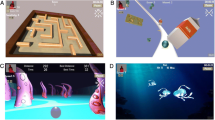Abstract
Effective stroke rehabilitation must be early, intensive and repetitive, which can lead to problems with patient motivation and engagement. The design of video games, often associated with good user engagement, may offer insights into how more effective systems for stroke rehabilitation can be developed. In this paper we identify game design principles for upper limb stroke rehabilitation and present several games developed using these principles. The games use low-cost video-capture technology which may make them suitable for deployment at home. Results from evaluating the games with both healthy subjects and people with stroke in their home are encouraging.
Similar content being viewed by others
References
Anderson, R.: The Aftermath of Stroke: The Experience of Patients and Their Families. Cambridge University Press, Cambridge (1992)
Borg, G.A.: Psychophysical bases of perceived exertion. Med. Sci. Sports Exerc. 14, 377–381 (1982)
Burdea, G.: Key note address: Virtual rehabilitation—benefits and challenges. In: 1st Intl. Workshop on Virtual Reality Rehabilitation (Mental Health, Neurological, Physical, Vocational), pp. 1–11 (2002)
Burke, J.W., McNeill, M.D.J., Charles, D.K., Morrow, P.J., McDonough, S.M., Crosbie, J.H.: serious games for upper limb rehabilitation following stroke. In: IEEE Intl. Conf. in Games and Virtual Worlds for Serious Applications (VS Games ’09), pp. 103–110 (2009)
Crosbie, J.H., McDonough, S.M., Lennon, S., Pokluda, L., McNeill, M.D.J.:Virtual reality in the rehabilitation of the upper limb after stroke: The user’s perspective. In: 5th Intl. Conf. for Disability, Virtual Reality and Associated Tech., pp. 215–224 (2004)
Desurvire, H., Caplan, M., Toth, J.A.: Using heuristics to evaluate the playability of games. In: Proc. ACM Conference on Human Factors in Computing Systems (SIGCHI)’04, pp. 1509–1512 (2004)
GestureTek: http://www.gesturetekhealth.com/ (2008)
Jack, D., Boian, R., Merians, A., Tremaine, M., Burdea, G., Adamovich, S.: Virtual reality-enhanced stroke rehabilitation. IEEE Trans. Neural Syst. Rehabil. Eng. 9, 308–318 (2001)
Koster, R.: A Theory of Fun for Game Design. Paraglyph, Arizona (2005)
Kwakkel, G., Wagenaar, R.C., Twisk, J.W., Lankhorst, G.J., Koetsier, J.C.: Intensity of leg and arm training after primary middle-cerebral-artery stroke: a randomised trial. Lancet 354, 191–196 (1999)
Ma, M., McNeill, M., Charles, D., McDonough, S., Crosbie, J., Oliver, L., McGoldrick, C.: Adaptive virtual reality games for rehabilitation of motor disorders. Lect. Not. Comput. Sci. 4555, 681–690 (2007)
Morrow, K., Docan, C., Burdea, G., Merians, A.: Low-cost virtual rehabilitation of the hand for patients post-stroke. In: Intl. Workshop on Virtual Rehabilitation ’06, pp. 6–10 (2006)
Peek, B.: Managed library for Nintendo’s Wiimote. http://www.brianpeek.com (2008)
Rand, D., Kizony, R., Weiss, P.L.: Virtual reality rehabilitation for all: Vivid GX versus Sony PlayStation II EyeToy. In: Proc. 5th Intl. Conf. on Disability, Virtual Reality & Associated Tech ’04, pp. 87–94 (2004)
Rizzo, A., Kim, G.J.: A SWOT analysis of the field of virtual reality rehabilitation and therapy. Presence 14, 119–146 (2005)
Salen, K., Zimmerman, E.: Rules of Play: Game Design Fundamentals. MIT Press, Cambridge (2003)
van der Lee, J.H., Wagenaar, R.C., Lankhorst, G.J., Vogelaar, T.W., Devillé, W.L., Bouter, L.M.: Forced use of the upper extremity in chronic stroke patients. Stroke 30(11), 2369–2375 (1999)
Wade, D.T., Wood, V.A., Hewer, R.L.: Recovery after stroke—the first three months. J. Neurol. Neurosurg. Psychiatry 48, 7–13 (1985)
Weiss, P., Kizony, R., Feintuch, U., Katz, N.: Virtual reality in neurorehabilitation. In: Textbook of Neural Repair and Neurorehabilitation, vol. 2, pp. 182–197 (2005)
Witmer, B.G., Singer, M.J.: Measuring presence in virtual environments: a presence questionnaire. Presence 7, 225–240 (1998)
Yavuzer, G., Senel, A., Atay, M.B., Stam, H.J.: Playstation Eyetoy games improve upper extremity-related motor functioning in subacute stroke: a randomized controlled clinical trial. Eur. J. Phys. Rehabil. Med. 44(3), 237–244 (2008)
Author information
Authors and Affiliations
Corresponding author
Additional information
http://php.infc.ulst.ac.uk/vr-therapy/.
This paper is an extension of a paper presented at the First International IEEE Conference in Serious Games and Virtual Worlds (VS Games) 2009 conference in Coventry, England [4].
Rights and permissions
About this article
Cite this article
Burke, J.W., McNeill, M.D.J., Charles, D.K. et al. Optimising engagement for stroke rehabilitation using serious games. Vis Comput 25, 1085–1099 (2009). https://doi.org/10.1007/s00371-009-0387-4
Published:
Issue Date:
DOI: https://doi.org/10.1007/s00371-009-0387-4




